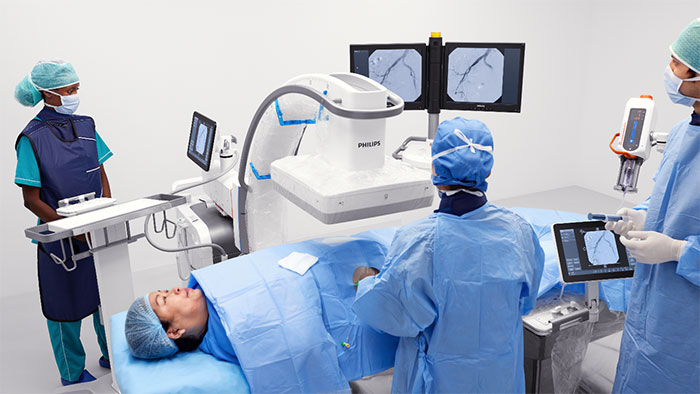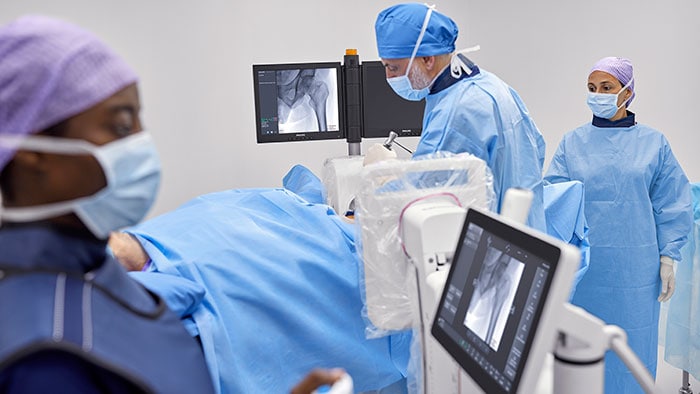Feb 09, 2022
Philips expands access to hemodynamics at point-of-care for real-time blood flow assessment on Handheld Ultrasound – Lumify
Amsterdam, the Netherlands – Royal Philips (NYSE: PHG, AEX: PHIA), a global leader in health technology, today announced it has expanded its ultrasound portfolio with advanced hemodynamic assessment and measurement capabilities on its handheld point-of-care ultrasound – Lumify. With the addition of Pulse Wave Doppler [1], Philips has greatly expanded the utility of its Handheld Ultrasound – Lumify – enabling clinicians to quantify blood flow in a wide range of point-of-care diagnostic applications – including cardiology, vascular, abdominal, urology, obstetrics and gynecology. Also new to Lumify are obstetric measurements to help in early assessment of gestational age and the identification of high-risk pregnancies.
Point-of-care hemodynamics
Pulse Wave Doppler ultrasound provides clinicians with more information, in addition to 2D and color imaging, to assess hemodynamic patterns to differentiate between arterial and venous blood flow and quantify hemodynamic function. The resulting hemodynamic measurements can enhance diagnostic confidence and timely clinical decision-making in virtually any care setting, including cardiology and emergency medicine. With these latest features, Philips’ easy-to-use fully integrated handheld ultrasound system – Lumify – brings together imaging tools across ultrasound platforms, leveraging the company’s expertise in cardiology and radiology. The Lumify system also provides clinicians with advanced analysis software and reporting tools, and access to tele-ultrasound capabilities (Lumify with Collaboration Live powered by Reacts) for live communication support to connect clinicians around the globe for real-time collaboration. “By applying Philips’ expertise in cardiovascular care, imaging and patient monitoring to Philips Handheld Ultrasound – Lumify – we are committed to deliver a dedicated, innovative point-of-care portfolio, enabling clinicians to quickly assess hemodynamics – including cardiovascular function, organ perfusion and fetal assessment – in a daily routine, to identify abnormalities and intervene quickly,” said Matthijs Groot Wassink, General Manager of Point of Care Ultrasound at Philips. “With the addition of Pulse Wave Doppler and enhanced obstetrics measurements, we have increased the number of markers on which diagnoses can be made, to deliver high quality imaging and enhance the evaluation and effectiveness of treatment in real-time.”
Having Color Flow Doppler (CFD) and Pulse Wave Doppler on a handheld device is game changing, allowing clinicians to take point-of-care ultrasound examinations to the next level.
Dr. Robert Jones
Professor of Emergency Medicine at the MetroHealth System, Cleveland, Ohio in the U.S.A.
“Having Color Flow Doppler (CFD) and Pulse Wave Doppler on a handheld device is game changing, allowing clinicians to take point-of-care ultrasound examinations to the next level,” said Dr. Robert Jones, Professor of Emergency Medicine at the MetroHealth System, Cleveland, Ohio in the U.S.A. Dr. Jones will discuss the clinical advantages and benefits of integrating CFD and Pulse Wave Doppler into the point-of-care ultrasound evaluation of acutely ill and injured patients in the Emergency Department in an upcoming webinar.
Philips B-lines software enhances heart and lung assessments in handheld ultrasound
In addition to adding Pulse Wave Doppler for hemodynamics, Philips is the first and only point-of-care ultrasound solution with B-lines (B-line quantification tool for ultrasound lung imaging) software and intelligent algorithms to enhance heart and lung assessments, which is critical when dealing with severe COVID cases. The pandemic has shown the relevance of lung ultrasound in the diagnosis and treatment of pneumonia, one of the most common complications of COVID-19. AI-enhanced automated algorithms looking for B-lines in lung fluid can help provide more objective data and interpretation.
Increased access to quality care
The continuous scanning, performance and portability of Philips Handheld Ultrasound – Lumify – brings a full diagnostic solution to care professionals at the bedside; both in and outside of the hospital. The innovative technology is also in widespread use in community-based mother and child care programs, providing access to quality healthcare for underserved communities worldwide, including a program in Kenya driven by the Philips Foundation to educate midwives to deliver ultrasound-based antenatal pregnancy screening in village clinics, while receiving telehealth support from radiologists at distance. For more information on the award-winning Philips Handheld Ultrasound – Lumify – and its tele-ultrasound capabilities (Lumify with Collaboration Live powered by Reacts), visit Philips point-of-care ultrasound for the latest on high-quality portable imaging. [1] Pulse Wave Doppler measurement is currently available on the Android Lumify app. Availability on the Apple iOS/ iPad iOS Lumify app is scheduled for the future.
About Royal Philips
Royal Philips (NYSE: PHG, AEX: PHIA) is a leading health technology company focused on improving people's health and well-being, and enabling better outcomes across the health continuum – from healthy living and prevention, to diagnosis, treatment and home care. Philips leverages advanced technology and deep clinical and consumer insights to deliver integrated solutions. Headquartered in the Netherlands, the company is a leader in diagnostic imaging, image-guided therapy, patient monitoring and health informatics, as well as in consumer health and home care. Philips generated 2021 sales of EUR 17.2 billion and employs approximately 78,000 employees with sales and services in more than 100 countries. News about Philips can be found at www.philips.com/newscenter.











